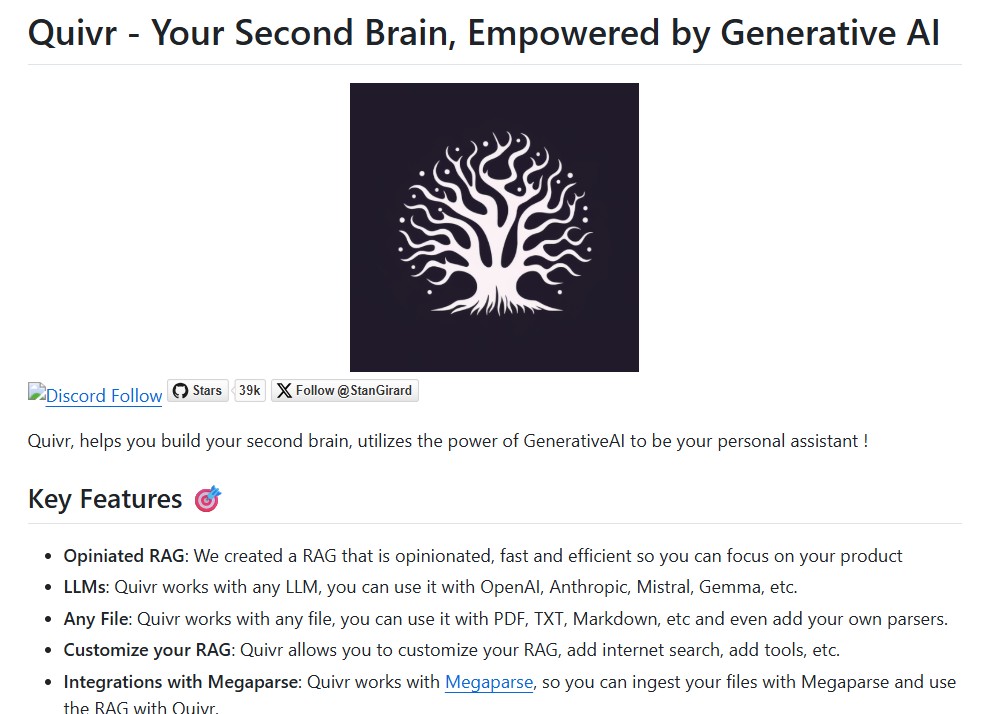In the rapidly evolving landscape of artificial intelligence, developers and businesses are seeking solutions that merge flexibility, power, and simplicity. Enter Quivr — an open-source framework designed to help you build your own “second brain” powered by Generative AI. Whether you’re an indie developer, startup founder or enterprise engineer, it makes it possible to integrate Retrieval-Augmented Generation (RAG) and large language models into your applications effortlessly.

In this blog, we’ll explore what Quivr is, how it works, its standout features and why it’s quickly becoming a favorite among AI developers across the world.
What is Quivr?
It is an open-source AI platform that enables you to create personalized knowledge systems often referred to as a “second brain.” Built on modern Generative AI technology, it allows users to ingest, retrieve and interact with their own data using natural language.
Think of Quivr as a modular, self-hosted assistant that can read your documents, remember information and answer complex questions about your data, all while maintaining privacy and flexibility.
The project is actively maintained by the QuivrHQ community and has gained immense popularity with over 38,000 GitHub stars. It’s built primarily in Python and integrates smoothly with popular LLMs such as OpenAI’s GPT-4, Anthropic’s Claude, Mistral, Gemma and even local models via Ollama.
Key Features
1. Opinionated RAG (Retrieval-Augmented Generation)
It offers a highly optimized and “opinionated” RAG workflow meaning it has pre-designed defaults that are efficient, fast and production-ready. This saves developers from having to build RAG pipelines from scratch.
With just a few lines of Python, you can ingest your data and start asking questions in natural language. This architecture ensures responses are contextually accurate and grounded in your documents, not just generated text.
2. Supports Any File Type
It works seamlessly with a variety of file formats — PDFs, TXT, Markdown, CSV, and more. It even supports custom file parsers, giving you full control over how data is ingested and interpreted.
This multi-file capability makes it ideal for organizations managing large documentation systems, customer support data or knowledge bases.
3. Integrations with Major LLM Providers
One of Quivr’s biggest strengths is its multi-LLM compatibility. You can easily switch between:
- OpenAI GPT-4
- Anthropic Claude
- Mistral
- Gemma
- Groq
- Or even local inference using Ollama
This flexibility ensures you’re not locked into one vendor and can optimize for cost, latency or performance.
4. Customizable Workflows
With Quivr, you can fully customize your RAG workflows using simple YAML configuration files. You can define retrieval nodes, reranker models, history depth and LLM parameters — all without rewriting code.
Developers can modify everything from temperature, max input tokens and reranking models to context window size enabling full control over the response behavior.
5. Internet Search and Tool Integration
Unlike traditional RAG frameworks, it lets you extend your model with internet search or connect it to external tools and APIs. This allows for dynamic retrieval and real-time intelligence — bridging the gap between static document knowledge and live web data.
6. Megaparse Integration
It integrates with Megaparse, enabling large-scale document ingestion and parsing. With Megaparse, you can preprocess and organize thousands of files, then plug them directly into your Quivr “brain” for instant Q&A and summarization.
7. Privacy-Friendly and Self-Hosted
In an age where data privacy is critical, Quivr stands out for allowing local deployment. Your data stays under your control — no external API calls are required unless you choose to use them.
This is a major advantage for developers working in regulated industries like healthcare, finance or education where data compliance matters.
Official Quivr GitHub Repository
Why Developers Love Quivr ?
It is not just another RAG tool — it’s a developer-friendly AI framework designed with simplicity and extensibility in mind.
- Fast setup: Install via
pip install quivr-coreand run within minutes. - Readable codebase: Built in clean, modular Python.
- Community-driven: With 100+ contributors and active updates.
- Enterprise-ready: Apache 2.0 license makes it free for both personal and commercial use.
The combination of flexibility, scalability, and transparency makes Quivr a favorite among both independent developers and AI teams in production environments.
Getting Started
If you want to try Quivr yourself, here’s a quick start:
pip install quivr-core
Then in Python:
from quivr_core import Brain
brain = Brain.from_files(name="my_brain", file_paths=["./docs.pdf"])
print(brain.ask("Summarize this document"))
You can create a YAML workflow file to define how the model retrieves, ranks, and generates answers. Quivr supports rerankers like Cohere’s multilingual models and can easily integrate into web apps or APIs.
Use Cases
It can be used in a wide variety of scenarios:
- Internal Knowledge Assistants – Help employees search internal documents.
- Customer Support Bots – Train AI agents on product manuals.
- Educational Tools – Summarize lessons and generate study materials.
- Data Analysis – Convert raw data into readable insights.
- Personal Knowledge Bases – Build your own intelligent memory system.
The possibilities are endless, especially as Quivr continues to evolve with more connectors and model integrations.
Conclusion: The Future of Intelligent Data Access
As AI becomes central to modern applications, frameworks like Quivr redefine how we interact with information. By merging retrieval, reasoning and generation, it empowers anyone to build AI systems that truly understand their data.
Its open-source foundation, flexible architecture, and strong community support make it a standout choice for developers looking to bring Generative AI capabilities into their products without reinventing the wheel.
If you’re building with AI, Quivr is not just another tool — it’s your second brain.
Follow us for cutting-edge updates in AI & explore the world of LLMs, deep learning, NLP and AI agents with us.
Related Reads
- Top 20 Ultimate Bollywood Diwali Portrait Ideas for Women Using Gemini AI
- Try Powerful Mem0 AI to build Long-Term Memory for AI Agents
- Grok AI Chatbot (2025): Elon Musk’s Bold Answer to Real-Time, Intelligent Conversation
- Artificial Intelligence: A Modern Approach — The Ultimate Number 1 Guide to Learning AI by Stuart Russell and Peter Norvig
- 15+ Gemini AI Photo Editing Prompts for Boys: Create Stunning Styles & Expressions in 2025
References
Official Quivr GitHub Repository

5 thoughts on “Quivr AI: Building Your Second Brain with Open-Source Generative Intelligence”